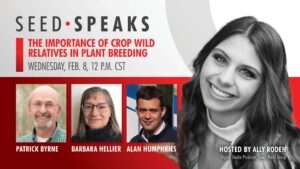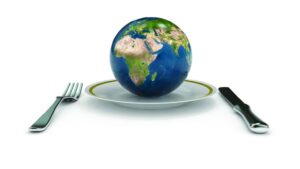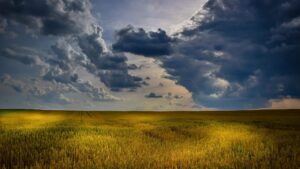It is no secret that food security is a rising issue across the globe. As experts search for ways to combat the increased food insecurity, one solution comes in the form of crops that are not new at all — wild relatives.
The process of breeding a new variety can be quite complex. When a breeder needs to create resistance in a crop, they typically begin by looking at what is already domesticated, mixing and matching while trying to breed something with resistance. If that is not successful, the breeder will go to old, cultivated varieties — the landraces or farmers’ varieties. If the breeder is still unable to find what they need, they will take a look at wild relatives.
On February 8 at 12:00 CST, the expert panelists on Seed Speaks will take a deep dive into the importance of wild relatives in plant breeding. Joining us are:
Patrick Byrne, plant geneticist in the Department of Soil and Crop Sciences at Colorado State University. Byrne is a plant geneticist in the Department of Soil and Crop Sciences at Colorado State University (CSU). His research has focused on the genetics of drought tolerance, disease resistance and agronomic traits in wheat, maize and dry beans. Byrne has had a long-term interest in evaluating and incorporating the genetic diversity of gene bank collections into breeding programs. He currently co-coordinates a project to develop learning materials on the conservation and use of plant genetic resources. Before coming to CSU in 1997, Byrne worked for USDA’s Agricultural Research Service (ARS) in Columbia, Missouri, and in agricultural development in Mexico, West Africa and Nepal.
Barbara Hellier, horticulture crops and Beta curator with the Western Regional Plant Introduction Station. Hellier has been the horticulture crops andBeta curator with the Western Regional Plant Introduction Station, part of the National Plant Germplasm System (NPGS), since 2000. She manages the NPGS collections of lettuce, Allium (all the species except for onion and bunching onion), beets and a wide range of genera that include minor forage legumes, ornamentals, medicinals, industrial crops and restoration and revegetation species. Crop plant wild relatives are a large part of her collections. Maintenance and regeneration activities for Hellier’s program routinely includes working with novel species, including crop wild relatives, with little or no published cultural information. Determining the best germination procedures, growth conditions and harvesting methods is common for her team. She has been involved in seven international and three domestic germplasm exploration trips which targeted wild species of Allium, Taraxacum, Beta, Daucus, forage legumes and medicinal species. Hellier has a master’s in Natural Resource Sciences from Washington State University and a BS from University of California, Davis. She is an avid gardener, hiker, traveler and animal lover.
Alan Humphries, curator of the Australian Pastures Genebank. Humphries is the curator of the Australian Pastures Genebank, a collection of some 80,000 accessions representing 2,600 temperate and tropical pasture legumes and grass species, collected from 178 countries. He is also an experienced alfalfa breeder and pre-breeder, with a 24-year history of leading the South Australian Research and Development Institute (SARDI) lucerne program in Australia. He has worked with the Crop Trust since 2015 to help scientists in Kazakhstan, China, Chile and recently Kyrgyzstan and Pakistan, to introgress crop wild relatives of alfalfa into their local breeding programs to improve climate adaptation.












